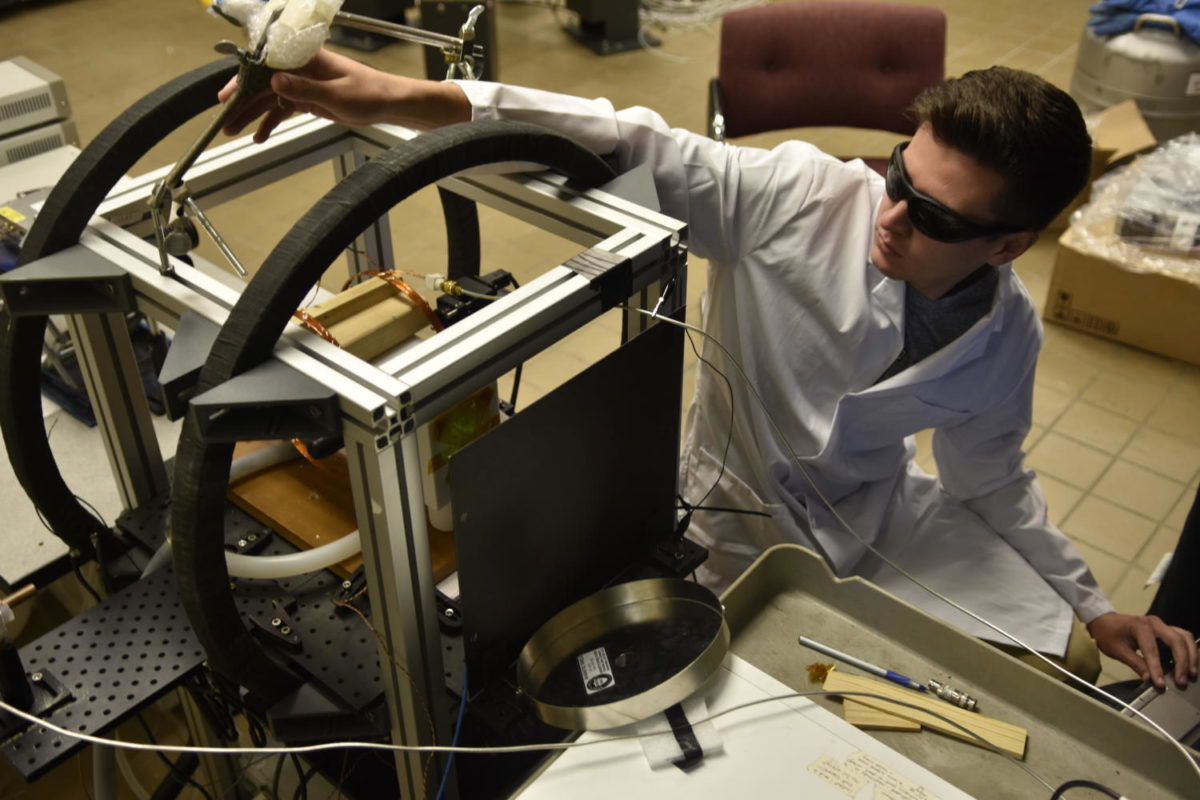From liquid to gas: chemistry students aim to make MRI’s easier and more accurate
Justin Porter, a junior from Rockford studying biological science, adjusts magnets on a laser to hyperpolarize Xenon Friday, Sept. 15, 2017, at a lab in Neckers. The element spins in two different directions and hyperpolarization involves making all the atoms spin in one direction. “If we can get to a point where we are producing the Xenon in great quantities, this can be [applied] in a hospital setting,” Porter said. “We’ll be able to help people.”
September 27, 2017
One research lab on campus is using chemistry and physics to put a new spin on how to image the lungs.
Justin Porter, a junior from Rockford studying biological sciences, has been working with chemistry professor Boyd Goodson for two years to study ways to make MRI’s — magnetic resonance imaging — both easier and more accurate for people with lung issues.
When MRI’s are taken, patients are given a liquid injection via IV that helps to image targeted organs such as the lungs, but scientists in Goodson’s lab are asking what would happen if instead of being liquid, MRI’s could be taken using gas.
Advertisement
“I wanted to be able to get into a research lab and start doing something that I think actually matters,” Porter said. “You get to do something that has the potential to help a lot of people.”
Compared to other parts of the body, Goodson said lung imaging is rather crude, which can be a setback when treating patients.
“Right now, the standard of care for pulmonary diagnostics is blowing into a tube, measuring that response in a bulk way,” Goodson said. “But that doesn’t give you information about the regional lung function. It doesn’t even tell you left from right.”
To go from liquid to gas, Porter and others in the lab work with the element xenon, specifically a type called xenon-129.
“Part of the technical development of the field has been taking it from an oddity in the lab to actually scaling it up and improving the efficiency in making a device a device you can put in a hospital,” Goodson said.
Xenon is an element Goodson has been working with for 20 years, starting as a graduate student conducting research at the University of California-Berkeley in the mid-’90s.
Goodson said the atoms naturally spin in two different directions, but to make xenon useful in MRI imaging atoms need to move in the same direction.
Advertisement*
The process Porter and Goodson perform to change the way the atoms spin is called hyperpolarization.
Goodson said it’s akin to the north and south poles of a magnet; in essence, they want to get as many xenon-129 atoms as possible to one “pole.”
Senior Megan Murphy, a Springfield native studying chemistry, said the team of nine students uses lasers to send out light that is absorbed by other elements. Those molecules can then transfer their energy to xenon to change its spin.
“These are very complex experiments,” Porter said. “That’s a pretty big step for an undergraduate. Working in research like this, not much is harder.”
That process is so complex because there are many variables the team has to account for, Porter said.
Besides being deemed safe for human use, xenon-129 must also be proven to help advance lung treatment in patients and be able to be stored for later use.
“We’re trying to make the xenon have a higher polarization to give us more magnetization, more signal,” Goodson said. “We want to make more of it and we want to make it faster — more and better and faster.”
Eventually, the xenon-gas imaging agent will need FDA approval. Xenon-129 is safe and is even found naturally in the air, Goodson said.
Some patients in research hospitals have already begun to use the breathable xenon, Goodson said. However, it has yet to be clinically approved and is not in non-researching hospitals.
It’s research like this that Murphy said is crucial in furthering her career.
“A lot of graduate school applicants have never been in a lab before they go to grad school,” she said. “The fact that I’m going to have four years of experience by the time I graduate is really awesome.”
Staff writer Cory Ray can be reached at cray@dailyegyptian.com or on Twitter @coryray_de.
To stay up to date with all your southern Illinois news, follow the Daily Egyptian on Facebook and Twitter.
Advertisement








